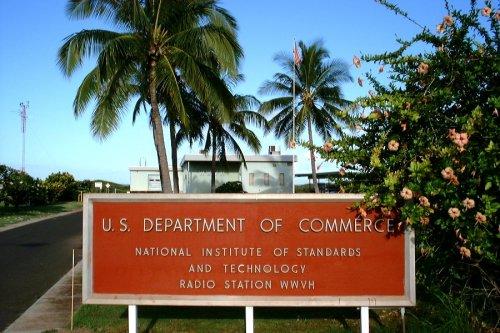Radio Station WWVH
Notice:
Since November 15, 2021, WWV and WWVH has been broadcasting a test signal on minute 8 of each hour on WWV, and minute 48 on WWVH. This signal has been created to assist in ionospheric research, and is a joint effort of the Ham Radio Citizen Science Investigation (HamSCI) and NIST. The signal consists of various tones, chirps, and Gaussian noise bursts. The signal may be modified occasionally. For more information on HamSCI and the WWV/WWVH project, click here.
| FAQ | Signal Format | Station Outages | Broadcast Schedule | Time Code | Telephone Time | WWVH History | WWVH Photos | QSL Gallery | Station Library |

NIST radio station WWVH broadcasts time and frequency information 24 hours per day, 7 days per week to listeners worldwide. The station is located on the Island of Kauai, Hawaii on a 12 hectare (30 acre) site near Kekaha at Kokole Point. The information broadcast by WWVH includes time announcements, standard time intervals, standard frequencies, UT1 time corrections, a BCD time code and geophysical alerts.
Broadcast Frequencies
WWVH operates in the high frequency (HF) portion of the radio spectrum and radiates 10 000 W on 10 MHz and 15 MHz, and 5000 W on 2.5 MHz. Notice: the 5 MHz broadcast which normally radiates 10 000 W is currently operating at 5000 W due to equipment failure.
Each frequency is broadcast from a separate transmitter. Although each frequency carries the same information, multiple frequencies are used because the quality of HF reception depends on many factors such as location, time of year, time of day, the frequency being used, and atmospheric and ionospheric propagation conditions. The variety of frequencies makes it likely that at least one frequency will be usable at all times.
Antennas
From 2000 to 2007, NIST has installed new antennas encased in fiberglass rather than traditional steel supports, to resist corrosion from the salty ocean air. The fiberglass design will reduce maintenance and repair costs. The new design also enables the flexible, lightweight antennas to be easily lowered to the ground for maintenance, reducing safety hazards to staff. The improved antennas should reduce signal downtime for WWVH users. The 5 MHz antenna system consists of half-wave phased array vertical antennas. The 2.5 MHz, 10 MHz and 15 MHz antennas are base-fed vertical monopoles that radiate omnidirectional patterns. Each frequency also has a vertical monopole standby antenna connected to the standby transmitters, in the event that the primary system fails.
WWVH Antenna Coordinates
| Frequency (MHz) | Latitude | Longitude |
|---|---|---|
| 2.5 | 21° 59' 20.9" N | 159° 45' 52.4" W |
| 5 | 21° 59' 10.8" N | 159° 45' 44.8" W |
| 10 | 21° 59' 18.2" N | 159° 45' 51.3" W |
| 15 | 21° 59' 15.3" N | 159° 45' 50.0" W |
Modulation
The signals broadcast by WWVH use double sideband amplitude modulation. The modulation level is 50 percent for the steady tones, 50 percent for the BCD time code, 100 percent for the second pulses and the minute and hour markers, and 75 percent for the voice announcements.
Other Information about WWV and WWVH
- NIST Time and Frequency Services (NIST Special Publication 432): A detailed 80 page overview of NIST time and frequency services and how to use them. Chapter 3 is all about WWV and WWVH.
- Frequently Asked Questions
- Manufacturers of Time and Frequency Receivers: Links to manufacturers of WWV/WWVH and other time and frequency receivers
Listener comments and reception reports may be emailed to: wwvh [at] nist.gov (wwvh[at]nist[dot]gov), or sent via postal mail to:
Postal mail:
NIST Radio Station WWVH
PO Box 417
Kekaha, HI 96752-0417
Contacts
-
WWVH

